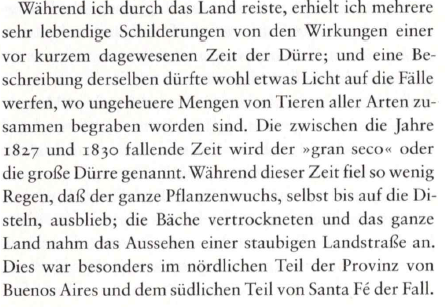Charles Darwin hat auf seiner Reise um die Welt vom 27. Dezember 1831 – 1836 in Südamerika, als er von Buenos Aires nach Santa Fe reiste, von einer 4-jährigen Dürre erfahren, die er auf den Seiten 89 bis 93 des Taschenbuchs beschreibt, die von 1827 bis 1830 geherrscht hat. Diese fand zur Zeit der Kleinen Eiszeit ( auf der Nordhalbkugel ) statt.

Buch: Reise eines Naturforschers um die Welt

+++
Eine neue Arbeit von Lapointe et al. 2020 findet im arktischen Nordatlantik in vorindustriellen Klimaarchiven einen deutlichen 11-jährigen Zyklus. Allerdings trauen sich die Autoren nicht, diesen endgültig als solar zu bezeichnen, weil das Klimamodell es nicht nachvollziehen kann. Außerdem weisen die Autoren eine AMO-Zyklik mit einer Periode von 40-80 Jahren (Mittelwert: 60 Jahre) für die vergangenen 400 Jahre nach. Die Kleine Eiszeit stellte das Kälteextrem der letzten 3000 Jahre dar.
+++
Ulf von Rauchhaupt in der FAZ am 19.10.2020:
Die Sonne erwacht
Auf unserem Gestirn war zuletzt eher wenig los. Das ändert sich gerade. Welche Folgen hat das für die Erde und ihr Klima? Und welche nicht?
Sonnenflecken sind für globale Pandemien verantwortlich. So stand es jedenfalls in Nature. Im Januar 1990 erschien dort ein Text, der den Zusammenhang auch anhand einer Kurve nahelegte: Von der Spanischen Grippe kurz nach dem Ersten Weltkrieg bis zur „Red Flu“ genannten Epidemie, die 1977 in Russland und China auftrat, fallen dort alle sieben Sonnenflecken-Maxima mit Grippeausbrüchen zusammen. Dergleichen wurde seit dem Ende der siebziger Jahre mehrfach behauptet. Dass es das Thema 1990 ins Fachjournal Nature schaffte, dürfte allerdings allein am Namen eines der beiden Autoren liegen: Sir Fred Hoyle (1915 bis 2001) war ein sehr prominenter Astrophysiker, der gleichwohl einigen eigenartigen Ideen anhing. So propagierte er bis zu seinem Tod eine kosmologische Theorie ohne Urknall. Und er glaubte fest an einen außerirdischen Ursprung des Lebens auf der Erde: Die ersten Zellen seien aus dem All auf unseren Planeten gerieselt. Dergleichen passiere noch heute, meinte Hoyle, weswegen die höhere Aktivität einer fleckigeren Sonne durchaus vermehrt schädliche Keime zur Erdoberfläche befördern könne.
Weiterlesen in der FAZ
+++
Pedersen et al. 2020 schreiben, dass die aktuellen Emissionen weit unterhalb des RCP 8.5-Emissions-Szenarios liegen. Trotzdem plädieren sie dafür, das Szenario weiter mitzuführen, für den Fall, dass China und Indien nochmal kräftig ihre CO2-Emissionen hochfahren:
Variability in historical emissions trends suggests a need for a wide range of global scenarios and regional analyses
Long-term developments in carbon dioxide emissions have tracked the middle of projected emission scenario ranges over the past three decades. If this tendency continues, it seems increasingly less likely that future emissions will follow current high-emission scenarios. However, in the past, periods of slow and fast global emissions growth was observed, which have led to previous critiques of scenarios being too low or too high. In the light of such unpredictability and since scenarios are meant to explore plausible futures, we here argue that a broad range of emission scenarios continue to be considered input in scenario-based analyses of future climate change. Furthermore, we find substantial regional differences in emissions trends. Territorial emissions in OECD countries fall on the low side of emission scenario ranges, whereas non-OECD territorial emissions fell closer to the medium or high-end. Since non-OECD emissions will become increasingly important, we recommend further exploring the relationships between regional and global emissions to support scenario assumptions and climate policymaking.
+++
Thapa et al. 2020 zeigen, dass der vermutete Zusammenhang des polwärtigen Verschiebens des Jetstreams mit AGW nicht so klar ist wie von einigen Protagonisten angenommen. Mithilfe von Proxys wird gezeigt, dass die Varianz in der Position seit 1850 anstieg, nur war sie davor bedeutend höher (vgl. Fig. 4). Der letzte Satz der Arbeit:
„Our multicentury HJL proxy could be used as a real-world target to compare against long model simulations, and thereby determine whether the enhanced variance and recent spate of poleward excursions is in fact unusual and due to either natural climate variability or anthropogenic climate change.“
Eine sehr milde Umschreibung für übertrieben sichere Modellvorhersagen der menschgemachten Verschiebung des Jetstreams zu den Polen hin.
+++
Laut Davidson (2014) geht die Zerstörung der globalen Feuchtgebiete weiter.
How much wetland has the world lost? Long-term and recent trends in global wetland area
It has been frequently stated, but without provision of supporting evidence, that the world has lost 50% of its wetlands (or 50% since 1900 AD). This review of 189 reports of change in wetland area finds that the reported long-term loss of natural wetlands averages between 54–57% but loss may have been as high as 87% since 1700 AD. There has been a much (3.7 times) faster rate of wetland loss during the 20th and early 21st centuries, with a loss of 64–71% of wetlands since 1900 AD. Losses have been larger and faster for inland than coastal natural wetlands. Although the rate of wetland loss in Europe has slowed, and in North America has remained low since the 1980s, the rate has remained high in Asia, where large-scale and rapid conversion of coastal and inland natural wetlands is continuing. It is unclear whether the investment by national governments in the Ramsar Convention on Wetlands has influenced these rates of loss. There is a need to improve the knowledge of change in wetland areas worldwide, particularly for Africa, the Neotropics and Oceania, and to improve the consistency of data on change in wetland areas in published papers and reports.
Dies bleibt nicht folgenlos für das Klima. Ein Wetland-Verlust beflügelt die Erwärmung über Land. Um das grob zu quantifizieren haben wir die Trends von 1950 bis heute des Amazonas-Gebiet (bis heute wetland) mit der Umgebung verglichen:

Das Amazonas- Gebiet hat sich in der Mitteltemperatur (bei der Maximaltemperatur wäre der Effekt noch ausgeprägter) um ca. 1/3 (Trend 0,01 K/a zur Umgebung Trend 0,015 K/a) langsamer erwärmt. Wenn man Fig. 4 des Papers hinzunimmt, so haben wir gegenüber 1950 ca 25% der wetlands verloren. Die dadurch zu erwartende Trenderhöhung wäre also bei Landflächen 8% (1/3*1/4). Für die globals (30% Land, 70% Wasser) würde dies bedeuten: 2,5 % des globalen Trends seit 1950 kommt von diesem Effekt.
Abbildung aus dem Climate Explorer.
+++
Enjoying the ice. Dutch Winter landscapes, weather and climate in the Golden Age, 17th century
This article explores Dutch winter landscapes from the 17th century, in light of written climatic sources. It investigates different kinds of climatic elements and winter weather types that were favoured by the artists during the Little Ice Age. The comparison between a corpus of paintings and narrative records show an overrepresentation of cold and dry weather in painted representations, in comparison to the written documents. Indeed, we can estimate that such particularly cold and dry weather corresponded to less than 20 % of winter days. Thus, the Dutch painters produced a winter imagery supported by icy scenes, in which the Dutch practiced skating. We interpret this choice by examining hypotheses based around four themes: climatic, religious, political, and social. Finally, despite their historical relevance, these winter landscapes are a genre, and only show very partially the diversity of winter weather during the 17th century and the Little Ice Age.
+++
Allen Freunden des Mittelmeerraumes sei diese Publikation ans Herz gelegt:
Climate and Environmental Change in the Mediterranean Basin
Current Situation and Risks for the Future
1st Mediterranean Assessment ReportThe First Mediterranean Assessment Report (MAR1) prepared by the independent network of Mediterranean Experts on Climate and environmental Change (MedECC) founded in 2015 is now finished. MedECC assesses the best available scientific knowledge on climate and environmental change and associated risks in the Mediterranean Basin in order to render it accessible to policymakers, stakeholders and citizens. The report includes a Summary for Policy-makers (SPM), which comprises the key messages of the MAR1.The report has been written by almost 190 scientists from 25 countries, all contributing in individual capacity and without financial compensation. The MedECC coordinators are very grateful for the expertise, rigor and dedication shown by the volunteer Coordinating Lead Authors and Lead Authors, working across scientific disciplines in each chapter of the report, with essential help by the many Contributing Authors. MedECC Authors and Coordinators want to thank all reviewers for their time and effort.
The UNEP/MAP – Barcelona Convention Secretariat, through its Plan Bleu Regional Activity Center, and the Secretariat of the Union for the Mediterranean work in partnership to support MedECC, and to contribute to establish a sound and transparent scientific assessment process. Many other institutions (specified in the “Front matter” and the Annex A of the report) also supported the preparation of this report.
+++
Climate and society in European history
This article evaluates 165 studies from various disciplines, published between 2000 and 2019, which in different ways link past climate variability and change to human history in medieval and early modern Europe (here, c. 700–1815 CE). Within this review, we focus on the identification and interpretation of causal links between changes in climate and in human societies. A revised climate–society impact order model of historical climate–society interactions is presented and applied to structure the findings of the past 20 years‘ scholarship. Despite considerable progress in research about past climate–society relations, partly expedited by new palaeoclimate data, we identify limitations to knowledge, including geographical biases, a disproportional attention to extremely cold periods, and a focus on crises. Furthermore, recent scholarship shows that the limitations with particular disciplinary approaches can be successfully overcome through interdisciplinary collaborations. We conclude the article by proposing recommendations for future directions of research in the climatic change–human history nexus.
Aus den Empfehlungen:
On the basis of this literature review, we propose the following recommendations for future research: (1) Enhanced interdisciplinary and international collaborations to overcome knowledge gaps and erroneous interpretations. (2) Creating, updating and improving key historical datasets relevant for climatic change–human history research, (3) To quantify the influence of different meteorological parameters on food production over different seasons at various spatial and temporal scales. (4) Conducting more local‐ to regional‐scale comparisons between areas which have different societal impacts and outcomes to the same changes in climate. (5) Assessing the possible relationships between the comparatively small long‐term changes in climate and the frequency and magnitude of weather events with direct impacts on human livelihood. (6) Pay attention to the cultural responses, such as adaptation and learning processes, not only at the “end” of the impact order pathway, but on every impact level from the first‐ to the third‐order level.
